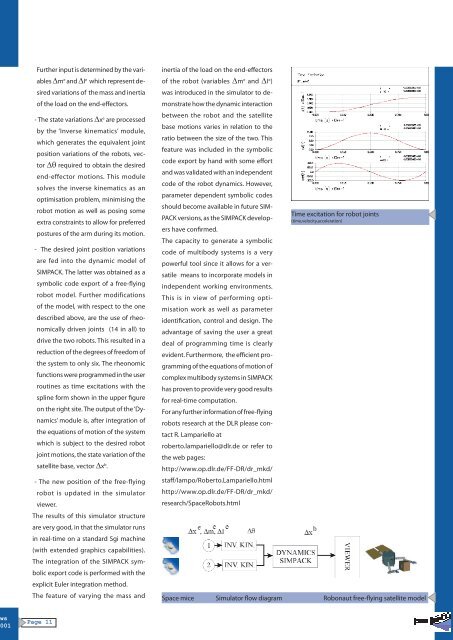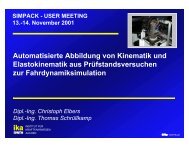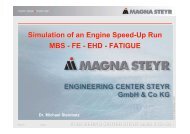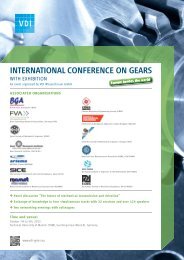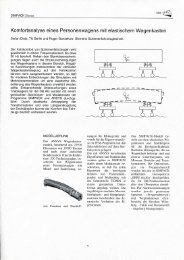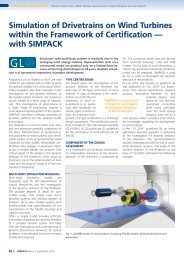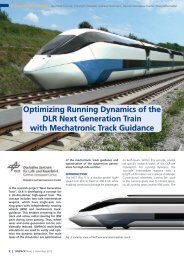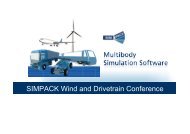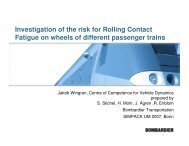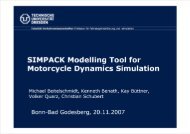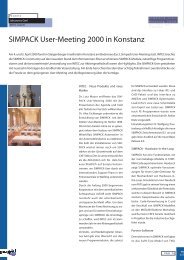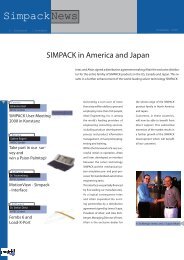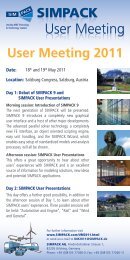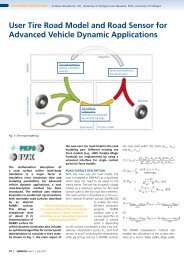SIMPACKNews
SIMPACKNews
SIMPACKNews
Create successful ePaper yourself
Turn your PDF publications into a flip-book with our unique Google optimized e-Paper software.
ws<br />
001<br />
Further input is de ter mined by the vari-<br />
ables ∆m e and ∆I e which represent de-<br />
sired variations of the mass and inertia<br />
of the load on the end-effectors.<br />
- The state variations ∆xe are processed<br />
by the ‘Inverse kinematics’ module,<br />
which generates the equi valent joint<br />
position variations of the robots, vec-<br />
tor ∆θ required to obtain the desired<br />
end-effector motions. This module<br />
solves the inverse kinematics as an<br />
optimisation problem, mini mising the<br />
robot motion as well as posing some<br />
extra constraints to allow for preferred<br />
postures of the arm during its motion.<br />
- The desired joint position variations<br />
are fed into the dynamic model of<br />
SIM PACK. The latter was obtained as a<br />
symbolic code export of a free-flying<br />
robot model. Further modifications<br />
of the model, with respect to the one<br />
described above, are the use of rheonomically<br />
driven joints (14 in all) to<br />
drive the two robots. This resulted in a<br />
reduction of the degrees of freedom of<br />
the system to only six. The rheonomic<br />
functions were pro gram med in the user<br />
routines as time excitations with the<br />
spline form shown in the upper figure<br />
on the right site. The output of the ‘Dynamics’<br />
module is, after integration of<br />
the equations of motion of the system<br />
which is subject to the desired robot<br />
joint motions, the state variation of the<br />
satellite base, vector ∆xb .<br />
- The new position of the free-flying<br />
robot is updated in the simu lator<br />
viewer.<br />
The results of this simulator structure<br />
are very good, in that the simulator runs<br />
in real-time on a standard Sgi machine<br />
(with extended graphics capabilities).<br />
The integration of the SIMPACK symbolic<br />
export code is performed with the<br />
explicit Euler integration method.<br />
The feature of varying the mass and<br />
Page 11<br />
inertia of the load on the end-effectors<br />
of the robot (variables ∆me and ∆Ie )<br />
was introduced in the simulator to demonstrate<br />
how the dynamic inter action<br />
between the robot and the satellite<br />
base motions varies in relation to the<br />
ratio between the size of the two. This<br />
feature was included in the symbolic<br />
code export by hand with some effort<br />
and was validated with an independent<br />
code of the robot dy namics. However,<br />
para meter depen dent symbolic codes<br />
should become avai lable in future SIM-<br />
PACK versions, as the SIMPACK develop-<br />
ers have confirmed.<br />
The capacity to generate a symbolic<br />
code of multibody systems is a very<br />
powerful tool since it allows for a versatile<br />
means to incorporate models in<br />
independent working environments.<br />
This is in view of performing optimisation<br />
work as well as parameter<br />
identification, control and design. The<br />
advantage of saving the user a great<br />
deal of programming time is clearly<br />
evident. Furthermore, the efficient programming<br />
of the equations of motion of<br />
complex multibody systems in SIMPACK<br />
has proven to provide very good results<br />
for real-time com pu tation.<br />
For any further information of free-flying<br />
robots research at the DLR please contact<br />
R. Lampariello at<br />
roberto.lampariello@dlr.de or refer to<br />
the web pages:<br />
http://www.op.dlr.de/FF-DR/dr_mkd/<br />
staff/lampo/Roberto.Lampariello.html<br />
http://www.op.dlr.de/FF-DR/dr_mkd/<br />
research/SpaceRobots.html<br />
Time excitation for robot joints<br />
(time,velocity,acceleration)<br />
Space mice Simulator flow diagram Robonaut free-flying satellite model


